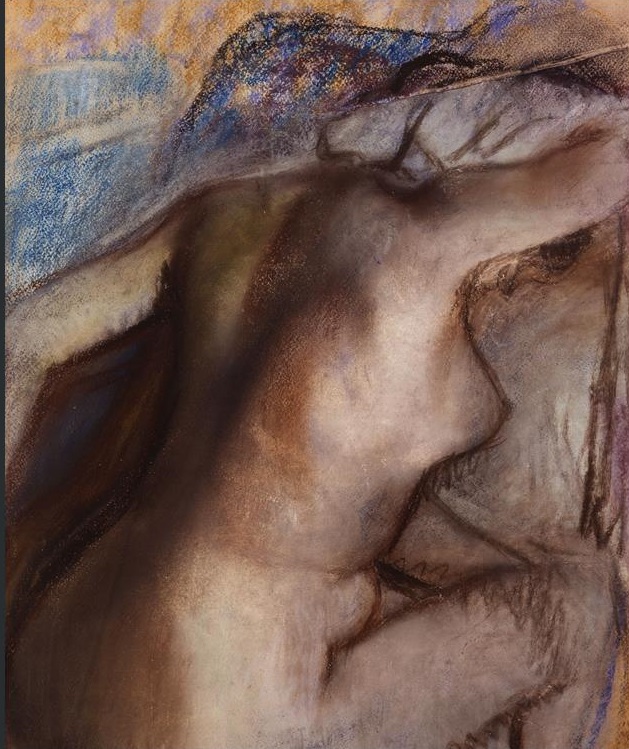art-Degas.com
Edgar Degas 1834-1917
Edgar Degas - After Bathing, Woman Drying Herself 1900
 After the Bath, Woman Drying Herself |
From Musée d’art moderne André Malraux, Le Havre:
At an auction in Paris in 1908, Olivier Senn, an art collector from Le Havre, bought his first pastel by Edgar Degas (1834–1917), a woman washing herself. At this time, artworks by the withdrawn artist were already rare on the market and negotiated at very high prices. Upon Degas' death, his studio collection was dissolved over four public sales. A big event, these open auctions drew the greatest collectors from France and abroad. Olivier Senn, who under no circumstances wanted to miss this opportunity, was there the first day of the first sale, on May 6, 1918, and came away with a substantial set of forty-six drawings. He sent a representative for the following auctions, but not without giving very specific purchasing instructions. This is how he obtained the pastel, one of the highest transactions of the second auction. Sold for 26,000 francs, this artwork is without a doubt one of the masterpieces of the Olivier Senn collection.
Degas executed his first pastels of women washing themselves around 1876–1877. He produced another extensive series in the 1880s and exhibited seven of the works at the eighth and final Impressionist exhibition in 1886. The series, entitled "Suite of female nudes, bathing, washing, drying themselves, wiping themselves, combing their hair or having their hair combed", inspired harsh criticism and fuelled the controversy on the artist's misogyny.
Captured in the privacy of their bedroom, as if unbeknownst to them, the women go about their bathing. The artist shows them crouching in their tub (a large, flat basin), rinsing, standing, drying themselves on a chair or armchair... The unaffected gestures are highlighted by views from above and truncated frames replicated by the artist drawing after drawing.
In our pastel, the young woman in three-quarter profile, her face bent forward hidden by her raised right arm, is drying the nape of her neck with a towel. She is sitting on a settee, the back of which is upholstered with mauve and ultramarine fabric, in front of a bathtub that can be made out in the background to the left. The rather tight frame accentuates the young woman's outstretched body, her left arm thrown behind her, almost in line with the right arm raised in front.
The drawing is immediately intriguing by its complexity. Two aspects especially draw the most attention: the long fold of paper in the upper right, like a scar that divides two sections treated in very different manners; and the work of the pastel itself, powdery on rough paper at one end, smooth and polished at the extreme of the other.
It would seem that Degas worked in two stages, first concentrating on the woman's body, then reworking his drawing to complete certain sections at the top of the sheet and defining the contours with hatching. The different treatments suggest that the drawing was reworked after several years and, by stylistic comparison, likely between 1880 and 1890.
Degas experiments here with all of the resources pastel has to offer: powdery and adhering unevenly to the coarse-grained paper, applied in successive layers, dampened to obtain a homogenous paste delicately worked to recreate the plasticity, fullness and softness of the female skin tone. Although the fold most likely occurred when the pastel was dampened, Degas did not try to conceal it; on the contrary, he accepted the accident for the possibilities it provided him and used it as a source of innovation.
Complex by its execution, intriguing by the questions it raises on the stages of its creation, After the Bath, Woman Drying Herself is above all an extremely sensual work, in which the woman's body is almost demanding to be caressed.